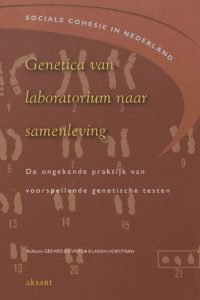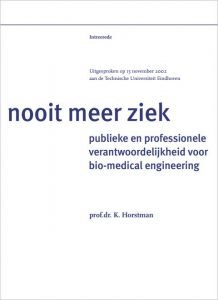Amsterdam: Babylon-De Geus, 1996 – ISBN 906222315X
In de moderne verzorgingsstaat is het vanzelfsprekend geworden dat artsen fungeren als poortwachters van levensverzekeringsmaatschappijen. In dit boek onderzoekt Klasien Horstman hoe deze poortwachtersfunctie aan het einde van de vorige eeuw tot stand kwam en hoe zij zich verder ontwikkelde.
De medische wetenschap verschafte de levensverzekeringsmaatschappijen aanvankelijk een aureool van betrouwbaarheid waarmee zij hun positie wisten te verstevigen. Maar naarmate de maatschappijen in de samenleving verankerd raakten, werd er getornd aan de invloed van de artsen. Zij bewaken nog wel de poort, maar uiteindelijk bepaalt de directie van de verzekeringsmaatschappij wie wel of niet wordt toegelaten.
“Insured Life. Horstman’s study differs. Here, too, many pages detail ideological stories, professional interests, and sociological concepts. But on other pages, we are amid urethras or we feel the naked bodies of insurance candidates through the hands of the medical examiner. And the examination form still waits to be filled in. In Verzekerd Leven, even the nonhumans are present more explicitly.
Whether you want a job or want to be declared incapacitated, whether you want to take out a life insurance policy or a funeral insurance policy, without a medical certificate you will not succeed-not in the Netherlands at least. Sometimes you are allowed to fill in such a certificate yourself, but most of the time the judgment of a medical expert is required: either the general practitioner or, more often, a special medical examiner. Consequently, these examiners function as the gatekeepers to all kinds of care arrangements, organized either by the state or the market. Nobody is surprised anymore by these facts today. After all, as sociologists of professions and medical historians argue, medical experts preeminently dispose of the power and the knowledge to fulfill this role.
But the argument is wrong, as Horstman shows in her study about the genesis of medical advising, concentrating on the role of doctors in life insurance business. Their power appears to be relative. Other groups–insurers and clients, to mention only human actors-also played an important role around the turn of the century in the development of the “medical insurance regime” we are so used to today. The knowledge necessary for this regime-that is, the required medical expertise-was also not at hand. It had to be developed, sometimes even against current medical practices and views. In defending her first claim (about medical power), Horstman uses ideas and concepts from figurational sociology. By analyzing a series of controversies, she reconstructs the creation, development, and stabilization of a configuration of bonds between actors. For the history of the second question (concerning medical expertise), Horstman consults the field of science and technology studies. Using Latour’s translation model, she shows the huge amount of work that had to be done to create an independent practice of medical examination. Many barriers, cultural as well as material ones, had to be overcome for this purpose.
Armed with this theory, Horstman, like Bijsterveld, reacts against global sociological explanations of the development of an medical insurance regime-for example, in terms of modernization and rationalization. Horstman does not deny such tendencies, but they cannot be deployed as independent, explanatory variables because they are themselves a product of the process under review. Physicians do not work in an unproblematic context of social modernization; on the contrary, through their activities they themselves help to shape modernization and produce the coevolution of (medical) science and society.
Hans Harbers, Uncovered Boundaries: Historical Sociology and Actor Network Theory, in: Science, Technology, & Human Values, Vol. 23, No. 3 (Summer, 1998), pp. 351-361 (Sage Publications, Inc.)











